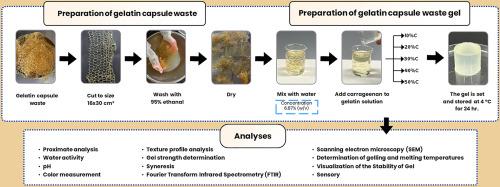Techno-functional gelling mechanism and rheological properties of gelatin capsule-waste gel modified with kappa-carrageenan for future functional food applications
IF 8.2
Q1 FOOD SCIENCE & TECHNOLOGY
引用次数: 0
Abstract
Gelatin capsule production generates large amounts of waste. Repurposing this waste into hydrogels offers a sustainable solution. This study investigated the techno-functional gelling mechanism and rheological properties of gelatin waste gel with added carrageenan, aiming to enhance the gel’s potential for future functional food applications. Gelatin capsule waste (GCW) was substituted with carrageenan at different levels (0 %, 10 %, 20 %, 30 %, 40 %, or 50 % w/w). The texture profile analysis and gel strength increased with the addition of carrageenan, accompanied by changes in the spectra obtained from Synchrotron Radiation-based Fourier-Transform Infrared Spectroscopy (SR-FTIR), which identified intermolecular and intramolecular interactions between the gelatin and carrageenan. The rheological measurements revealed that the incorporation of carrageenan influenced the elastic modulus (G’) and loss modulus (G’’) of the substituted GCW gel, as observed from the temperature sweep, which coincided with the higher gelling and melting temperatures (p < 0.05). The substituted GCW gels had a higher turbidity than the GCW gel without substitution, as confirmed by a decreased L* value. The water activity of the GCW gel remained stable with the addition of carrageenan. Based on the gel microstructure, the GCW gel had a looser gel network with larger voids, whereas the substituted gels had a finer network with smaller voids. However, there was a decrease in the overall likeness score for the gels substituted with carrageenan, especially at higher levels. In summary, the incorporation of carrageenan into GCW gel significantly influenced its rheological and textural properties. At an optimal substitution level, the GCW gel with carrageenan had strong potential as a functional material for food applications, particularly in soft confectionery.

明胶胶囊-卡帕-卡拉胶改性废凝胶的功能胶凝机理及流变性能研究
明胶胶囊的生产产生了大量的废物。将这些废物重新利用成水凝胶提供了一个可持续的解决方案。研究了添加角叉菜胶的明胶废凝胶的工艺功能胶凝机理和流变性能,旨在提高凝胶在未来功能食品中的应用潜力。用不同水平(0%、10%、20%、30%、40%或50% w/w)的卡拉胶代替明胶胶囊废物(GCW)。凝胶的结构分析和凝胶强度随着卡拉胶的加入而增加,同时基于同步辐射的傅里叶变换红外光谱(SR-FTIR)的光谱也发生了变化,这表明明胶和卡拉胶之间存在分子间和分子内的相互作用。流变学测量表明,从温度扫描观察到,卡拉胶的掺入影响了取代的GCW凝胶的弹性模量(G′)和损失模量(G′),这与较高的胶凝和熔化温度(p <;0.05)。取代GCW凝胶的浊度比未取代GCW凝胶的浊度高,L*值减小。加入卡拉胶后,GCW凝胶的水活度保持稳定。从凝胶微观结构来看,GCW凝胶的凝胶网络较为松散,孔隙较大,而取代凝胶的凝胶网络较为精细,孔隙较小。然而,用卡拉胶代替的凝胶的整体相似性得分有所下降,尤其是在较高的水平上。综上所述,卡拉胶加入GCW凝胶对其流变性能和结构性能有显著影响。在最佳替代水平上,卡拉胶GCW凝胶具有很强的食品功能材料应用潜力,特别是在软性糖果方面。
本文章由计算机程序翻译,如有差异,请以英文原文为准。
求助全文
约1分钟内获得全文
求助全文
来源期刊

Future Foods
Agricultural and Biological Sciences-Food Science
CiteScore
8.60
自引率
0.00%
发文量
97
审稿时长
15 weeks
期刊介绍:
Future Foods is a specialized journal that is dedicated to tackling the challenges posed by climate change and the need for sustainability in the realm of food production. The journal recognizes the imperative to transform current food manufacturing and consumption practices to meet the dietary needs of a burgeoning global population while simultaneously curbing environmental degradation.
The mission of Future Foods is to disseminate research that aligns with the goal of fostering the development of innovative technologies and alternative food sources to establish more sustainable food systems. The journal is committed to publishing high-quality, peer-reviewed articles that contribute to the advancement of sustainable food practices.
Abstracting and indexing:
Scopus
Directory of Open Access Journals (DOAJ)
Emerging Sources Citation Index (ESCI)
SCImago Journal Rank (SJR)
SNIP
 求助内容:
求助内容: 应助结果提醒方式:
应助结果提醒方式:


